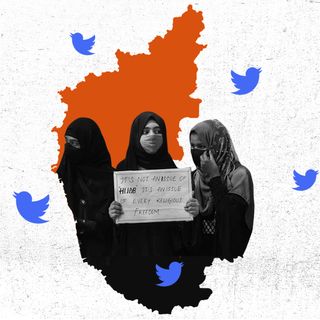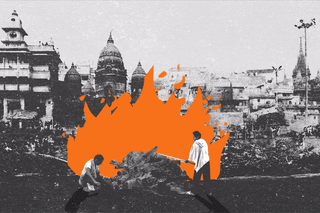
For Banaras’s Cremation Workers, Social Hierarchy Within the Community Reinforces Caste Exploitation
Elites in Dom communities create a narrative that the community has progressed away from caste and casteism — which is far from the truth.

On a bright hot day at the Manikarnika ghat of Banaras, Kundan Kumar Chaudhary, a Dom-worker, had just finished burning one of the several corpses for the day. As a person from the Dom caste, it is his caste-based livelihood to burn corpses at the ghats.
As Kundan looked for a place to sit for a bit, he heard abuses being shouted at him for slacking. It was Shalu Chaudhary, another Dom who was resting in the shade nearby. Shalu is part of the Dom-elite, belonging to the family of the Dom Raja (king of all Doms). He is thus exempt from work and can instead reap all the profits from other Doms working under him.
“These maaliks (owners) from the Dom Raja family only sit around and make us work. You saw how he didn’t even let me take some rest!” complains Kundan.
***
The occupation of funeral work is an important task at the ghats of Banaras, taken up solely by the men of the Dom community. The two major ghats, the Harishchandra ghat, and Manikarnika ghat have crematoriums where all the Doms work. Engaged in this line of work for centuries, a population of around 20,000 lives by the Ganga within the city. This work also largely sustains the economy of the ghats.
The people from the Dom caste in Banaras are peculiarly tied to a rigid system, called the paari system, that enables the daunting funeral work of burning corpses. But it also creates a divide within the community. A few families in the Dom community are middle class and thus relatively privileged as compared to the ever-toiling Dom workers, who are the majority. The system only benefits the middle-class elites at the cost of exploiting the Dom workers; an exploration of this system and the culture of the Dom community reveals many new truths about caste and how it is intertwined with class and religious culture of the city of Banaras.
The paari system is essentially a work-distribution system that provides every Dom a “turn” to take part in the business of corpse-burning. According to the system, every Dom family is given a set number of days to work in a year.
Mangal Chaudhary, a Dom-worker at Harishchandra ghat, explains that “everyone’s paari is set in a year. Some get 2 days a year, some get 5; many don’t get any.”
A majority of people from the Dom community have a similarly limited number of days of paari. Hence, they have no choice but work endlessly throughout the day and night to cremate the maximum number of corpses and earn enough money. “I have three days of paari right now; I have finished two days and have worked continuously for the last 48 hours,” says Mangal.
The rest of the year, the Doms work under the paari of other Doms. Owing to the corrupt system, the sons-in-law of the late Dom Raja, Jagdish Chaudhary, get the highest number of paari days. “The two sons-in-law get 4 months each of paari. Part of the remaining 4 months of a year also belong to other members of the Dom Raja family,” said Atul Chaudhary, another Dom-worker. It is these elites who benefit the most from the paari system. Naturally then, to earn a livelihood, most Dom-workers work under the Dom-elites throughout the year.
Related on The Swaddle:
In Banaras, Casteism and an Alcoholism Epidemic Are Criminalizing the Local Mallah Community
In their extensive research on the Doms of Banaras, scholars Sarita Kumari and Nemethianngai Guite note that “ordinary Doms earn minimum daily work and minimum monthly income, because of which the condition of ordinary Doms is pitiful. There are power dynamics within the occupational categories.”
Speaking of the inequality of paari among the community, Kundan says, “There are poor people in our community who get exactly two days of paari in 2 to 3 years. A lucky few get a week or so in a year.” He shows his blistered hands, complaining that the smoke and flames from burning pyres is extremely harmful. “Many people get problems related to the eyes and lungs. Eyes get weaker and their lungs secrete too much phlegm. If you stand in smoke will you be able to see anything? We stand for a whole day!”
The work of a Dom is a difficult and daunting task. Construction of the pyre by arranging heavy planks of wood is followed by putting the corpse on a pyre. The Dom worker has to then light it and stand beside the extreme heat, because the Dom worker has to ensure that the corpse is completely reduced to ashes. They do this by turning the body with a stick to completely burn it. Injuries and blisters are thus commonplace. Under the same wages, they also perform the work of cleaning the ashes at the ghats. Precarious work conditions and diminutive wages all contribute to an exploitation of the Dom-workers.
The price for cremating one corpse in the region is fixed at Rs. 200, paid by the family of the deceased. And only around 2 to 3 corpses can be completely cremated by a Dom in a day. Although the family of the deceased can make other contributions, in the form of alms, gold, or extra money, all of this goes to the paari holder, which is most often the Dom-elites.
The Dom Raja family keeps the records of days of paari of every Dom and maintains their hegemony by acting as the administrative authority for the business of corpse burning. A large part of this hegemony comes from their claim to the sacred fire which is the first step to the final rights of a corpse. Mangal explains how “for every corpse that burns at the ghats, the family members of the dead must first visit Mukti Dham (where the sacred fire is kept) and pay a sum to the Dom Raja to take the fire.” The sacred fire is said to have been kept burning by the Dom Raja family for centuries. This gives the Dom Raja elites immense status and respect within the community as well as in the city of Banaras.
Even though such religiously sanctioned work is performed by the Doms, they are placed at the bottom of the caste hierarchy and are a Dalit caste. They usually face untouchability by the rest of the society around the ghats. “Nobody around Manikarnika ghat wants to be near us. We can’t drink directly from the jugs of the shopkeepers, they pour it in our hands,” says Kundan.
Related on The Swaddle:
How ‘Faith Healing’ in Banaras Exploits People With Mental Illness
Even the Dom Raja himself is not immune to this casteism. Despite how culturally important he is considered, upper-caste visitors often don’t eat or drink at the Dom Raja’s house.
***
Doubly discriminated, first by caste society and then further by their Dom caste-elites due to a class hierarchy maintained through the paari system, the most astonishing part of the ordeals of the Doms is their fatalism against this double discrimination. Resistance to such a system is non-existent, no matter how exploitative it may be considered. Certain narratives are promoted and believed within the Dom community to inculcate a sense of caste pride.
The caste elites in the region go so far as to claim that casteism no longer exists or has become relatively insignificant. “10 to 20 years ago, we were discriminated against, but since then it hasn’t been a problem. We are treated as equals,” says Pawan Chaudhary, a member of the extended Dom family. What he perhaps fails to realize is that it is only his family that gets such respect.
The disavowal of every negative aspect regarding the Dom community, be it casteism or exploitation under the paari system, is all replaced by a pride in the cultural history of the Doms. “It is our birthright (janm siddh adhikaar), we are descendants of Kalu Ram Baba and God has given to us this huge responsibility, this karma, to provide moksha to the world, we shouldn’t question our karma,” says Pawan. He is talking about the popular cultural figure of Kalu Dom, said to be the first Dom.
Oft-repeated by many Dom-workers as well, the caste-cultural pride manifests through the myths weaved around Kalu Dom and the narrative of moksha by the sacred fire. Doms collectively claim to be the agents of moksha and thus part of a larger Hindu cultural identity.
The ideological framework of pride perpetuated by the Dom elites accomplishes two things. First, it disguises caste as culture. This also helps perpetuate the myth that the untouchable labor of a Dom has a higher goal. This cloaks the negative aspects of caste such as untouchability behind the larger cultural significance of the community. Subsequently, it prevents the development of class consciousness among the Dom-workers, who continue to deny or fail to question their own oppression by a middle-class that appropriates their labor.
However, Doms who take pride in their labor do not want their children to continue the same line of work. “I have two small children, and I want them to study and hopefully get a sarkari naukri (government job) in the future,” says Atul.
In order to truly forge a better future for the Dom workers and their children, they must first tackle the hegemony within their community by building class consciousness. Only then might it be possible for the corpse-burning dalits of Banaras to question the brahminical hegemony of the rest of the savarna castes who oppress and discriminate against them.
Kushal Choudhary is an independent journalist based in Banaras, exploring modernity and tradition through the lens of history and caste. Govind Sharma is an independent writer based in Varanasi exploring caste and social issues.
Related


Set Up 1 All‑Women Police Station per District as Women in Police ‘Abysmally’ Low: Parliamentary Panel
